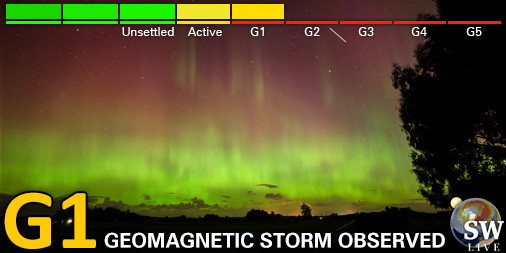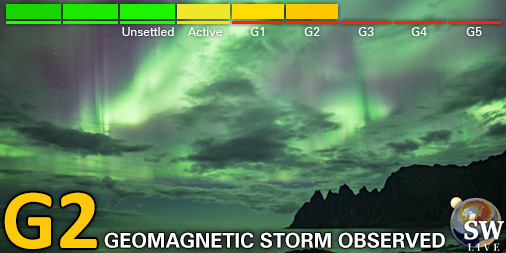Viewing archive of Tuesday, 10 April 2001
Solar activity report
Any mentioned solar flare in this report has a scaling factor applied by the Space Weather Prediction Center (SWPC). Because of the SWPC scaling factor, solar flares are reported as 42% smaller than for the science quality data. The scaling factor has been removed from our archived solar flare data to reflect the true physical units.
Report of Solar-Geophysical Activity 2001 Apr 10 2200 UTCPrepared by the NOAA © SWPC and processed by SpaceWeatherLive.com
Joint USAF/NOAA Report of Solar and Geophysical Activity
SDF Number 100 Issued at 2200Z on 10 Apr 2001IA. Analysis of Solar Active Regions and Activity from 09-2100Z to 10-2100Z
Solar activity remained at high levels. Region 9415
(S23W19) produced a long-duration X2/3b parallel-ribbon flare at
10/0526 UTC. This flare was associated with a 4000 SFU Tenflare,
Type II and IV radio sweeps, a 14-degree filament disappearance, and
a fast full-halo CME. Region 9415 showed decay in its trailer spots,
but maintained a strong magnetic delta configuration in its leader
portion, where a minor increase in spots was noted. Minor growth
occurred in Region 9417 (S08W39). It produced a C6/Sf at 10/1451
UTC. Minor growth was also observed in Region 9425 (S25W49). The
remaining regions were simply-structured and stable. No new regions
were assigned.
IB. Solar Activity Forecast
Solar activity is expected to be at
moderate to high levels. Region 9415 is expected to produce another
major flare during the period.
IIA. Geophysical Activity Summary 09-2100Z to 10-2100Z
Geomagnetic field activity ranged from quiet to active levels. A
greater than 10 MeV proton event followed today's X2/3b flare. It
began at 10/0850 UTC and was in progress as the period ended. The
greater than 10 MeV proton flux was near 100 PFU at the close of the
period and gradually increasing. A greater than 100 MeV proton flux
enhancement was also associated with the X2/3b flare. A polar cap
absorption (PCA) event began around 10/1200 UTC and continued as the
period ended. Thus far, maximum absorption associated with the PCA
event has been estimated at 8.5 dB. The greater than 2 MeV electron
flux reached high levels during the period.
IIB. Geophysical Activity Forecast
A major geomagnetic storm is
expected during 11 - 12 April in response to halo-CMEs observed on
09 - 10 April. Active to major storm levels are expected during this
disturbance with brief severe storm levels possible at high
latitudes. Unsettled to minor storm levels are expected on 13 April
as the storm subsides. The greater than 10 MeV proton event is
expected to continue through most of the period. The PCA event is
expected to end during the latter half of the period. The greater
than 2 MeV electron flux is expected to be at moderate to high
levels during the period.
III. Event Probabilities 11 Apr to 13 Apr
| Class M | 80% | 80% | 80% |
| Class X | 25% | 25% | 25% |
| Proton | 90% | 80% | 25% |
| PCAF | In Progress | ||
IV. Penticton 10.7 cm Flux
Observed 10 Apr 170 Predicted 11 Apr-13 Apr 165/165/160 90 Day Mean 10 Apr 167
V. Geomagnetic A Indices
Observed Afr/Ap 09 Apr 017/019 Estimated Afr/Ap 10 Apr 013/009 Predicted Afr/Ap 11 Apr-13 Apr 050/040-050/090-020/030
VI. Geomagnetic Activity Probabilities 11 Apr to 13 Apr
| A. Middle Latitudes | |||
|---|---|---|---|
| Active | 15% | 15% | 35% |
| Minor storm | 25% | 25% | 15% |
| Major-severe storm | 45% | 45% | 10% |
| B. High Latitudes | |||
|---|---|---|---|
| Active | 15% | 25% | 35% |
| Minor storm | 30% | 30% | 20% |
| Major-severe storm | 50% | 35% | 15% |
All times in UTC
Current data suggests there is a slight possibility for aurora to appear at the following high latitude regions in the near future
Whitehorse, YTAnchorage, AK, Fairbanks, AK, Juneau, AK
Latest news
Latest forum messages
Incoming & Unnumbered Active Regions 1661Unspecified geomagnetic activity 2221AR4048 114New satellites - Proba-3, PUNCH, SWFO-L1, GOES-U/19 36Filaments and prominences 750
More topicsSupport SpaceWeatherLive.com!
A lot of people come to SpaceWeatherLive to follow the Sun's activity or if there is aurora to be seen, but with more traffic comes higher server costs. Consider a donation if you enjoy SpaceWeatherLive so we can keep the website online!

Latest alerts
10:00 UTC - Hemispheric Power Index
The OVATION model predicts the Hemispheric Power Index to reach 78GW at 10:32 UTC
04:15 UTC - Geomagnetic activity
Minor G1 geomagnetic storm (Kp5) Threshold Reached: 04:05 UTC
03:15 UTC - Geomagnetic activity
Moderate G2 geomagnetic storm (Kp6) Threshold Reached: 02:59 UTC
01:00 UTC - Geomagnetic activity
Minor G1 geomagnetic storm (Kp5) Threshold Reached: 00:51 UTC
Friday, 4 April 2025
23:30 UTC - Geomagnetic activity
Minor G1 geomagnetic storm (Kp5) Threshold Reached: 23:17 UTC
Space weather facts
| Last X-flare | 2025/03/28 | X1.1 |
| Last M-flare | 2025/04/01 | M2.5 |
| Last geomagnetic storm | 2025/04/04 | Kp5+ (G1) |
| Spotless days | |
|---|---|
| Last spotless day | 2022/06/08 |
| Monthly mean Sunspot Number | |
|---|---|
| March 2025 | 134.2 -20.4 |
| April 2025 | 148 +13.8 |
| Last 30 days | 130.9 -15.2 |






